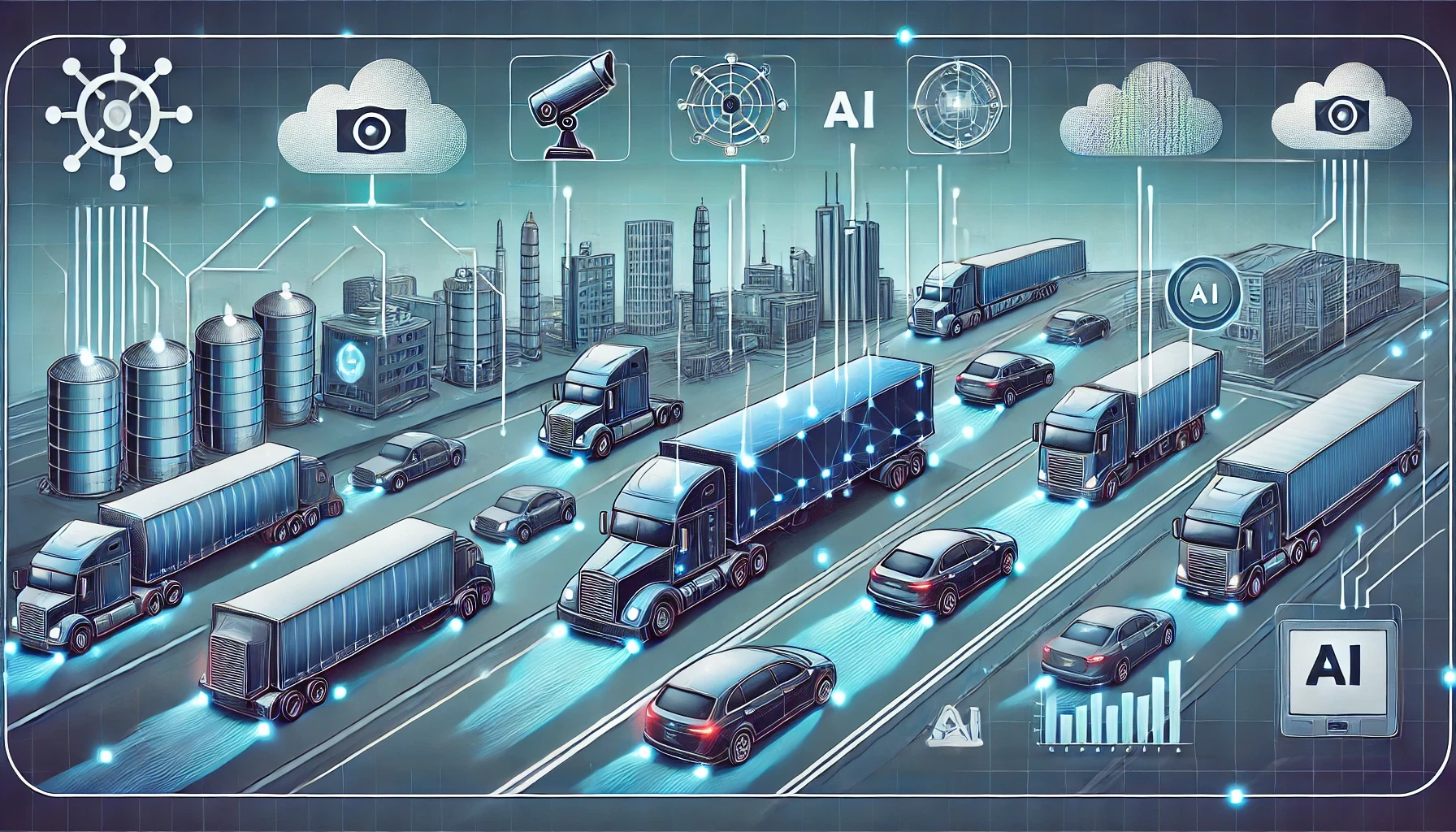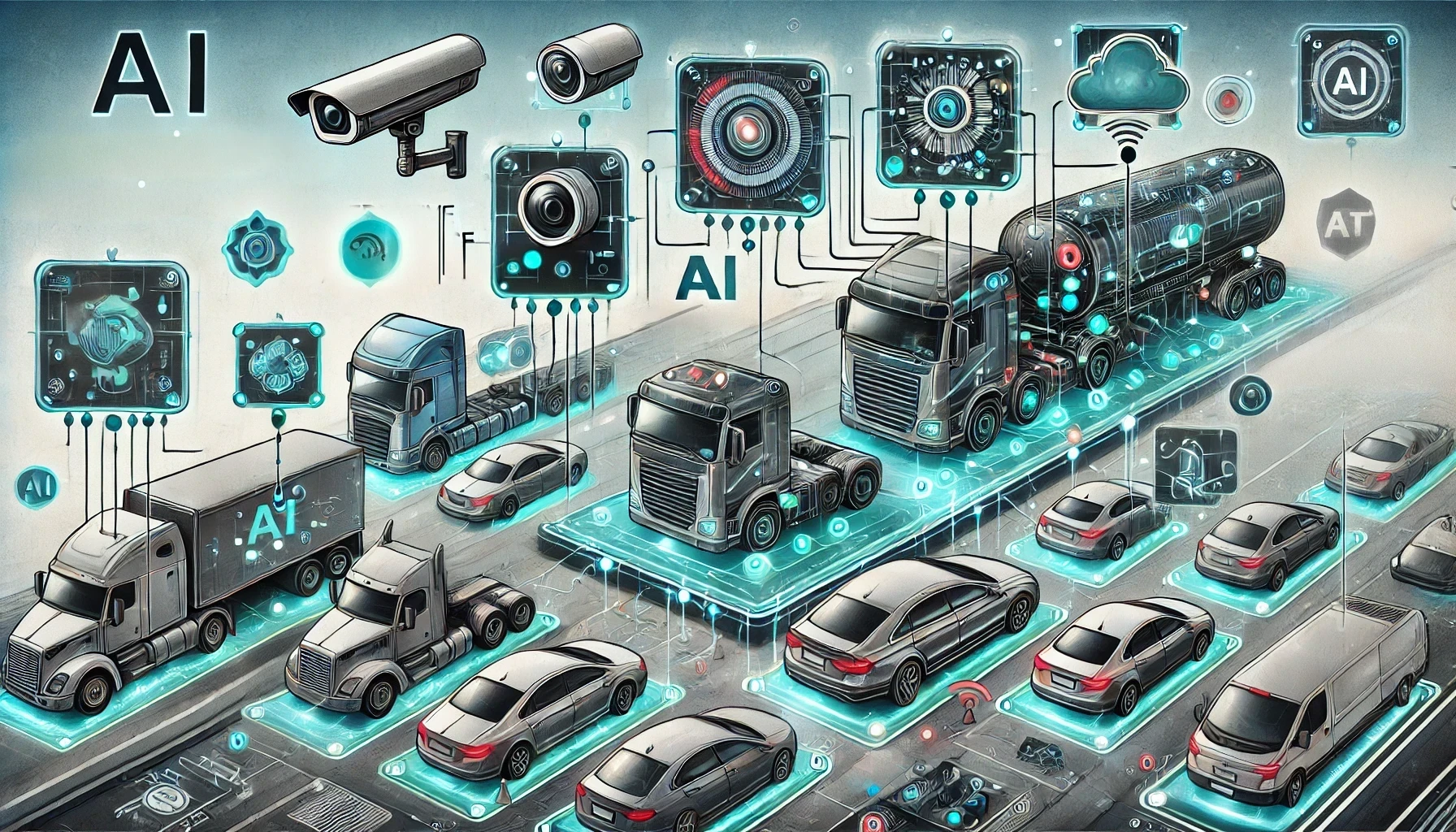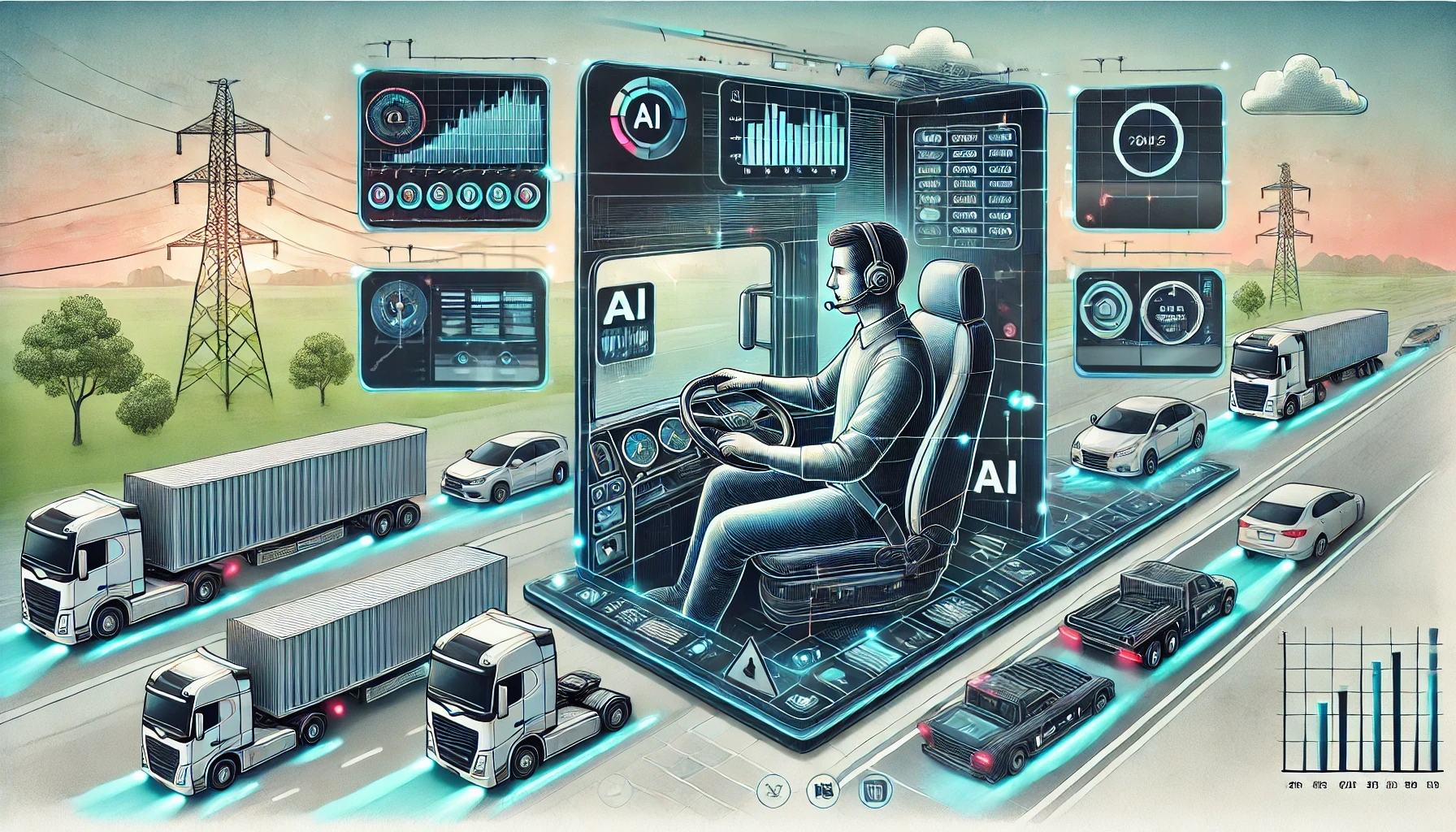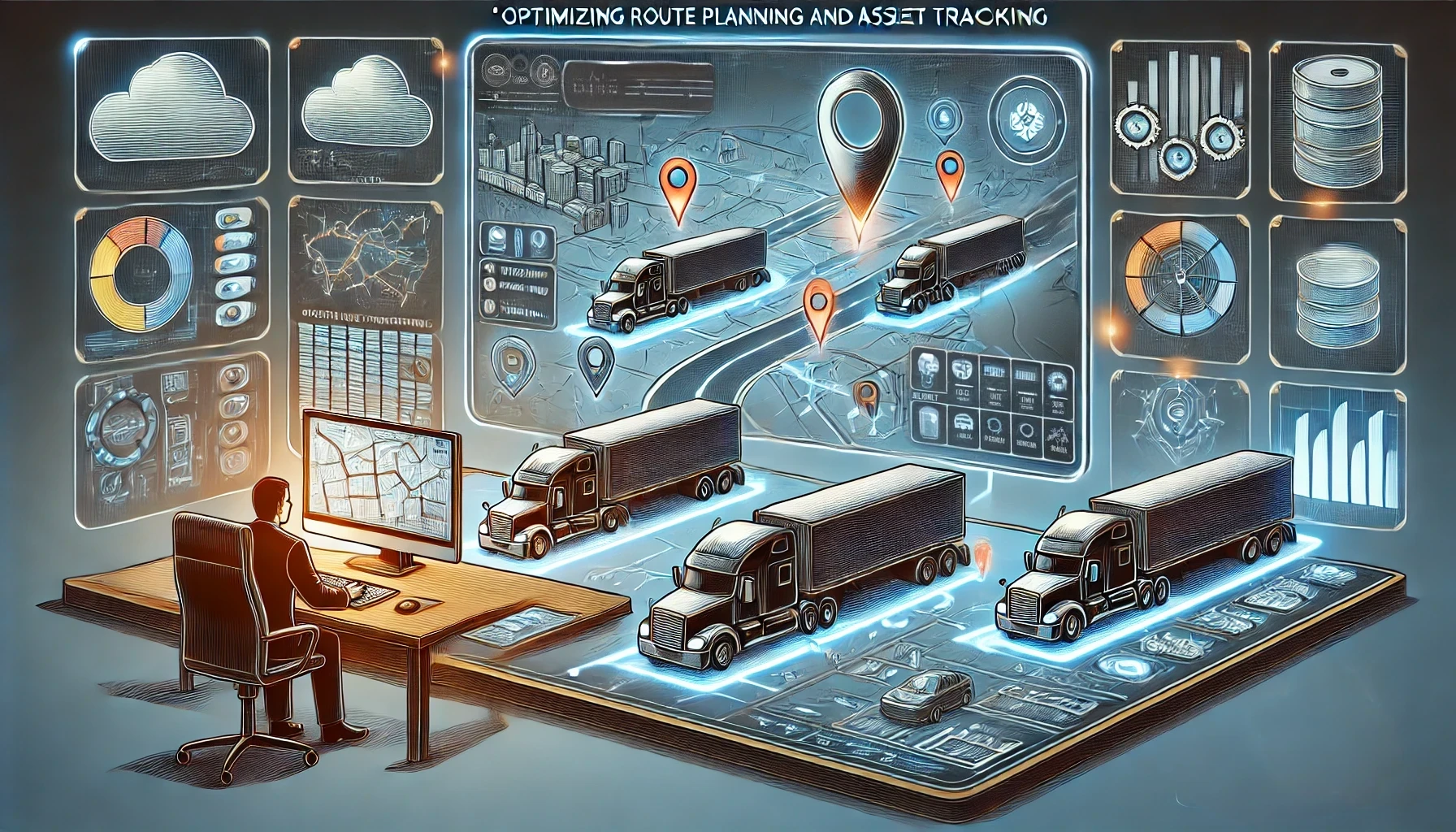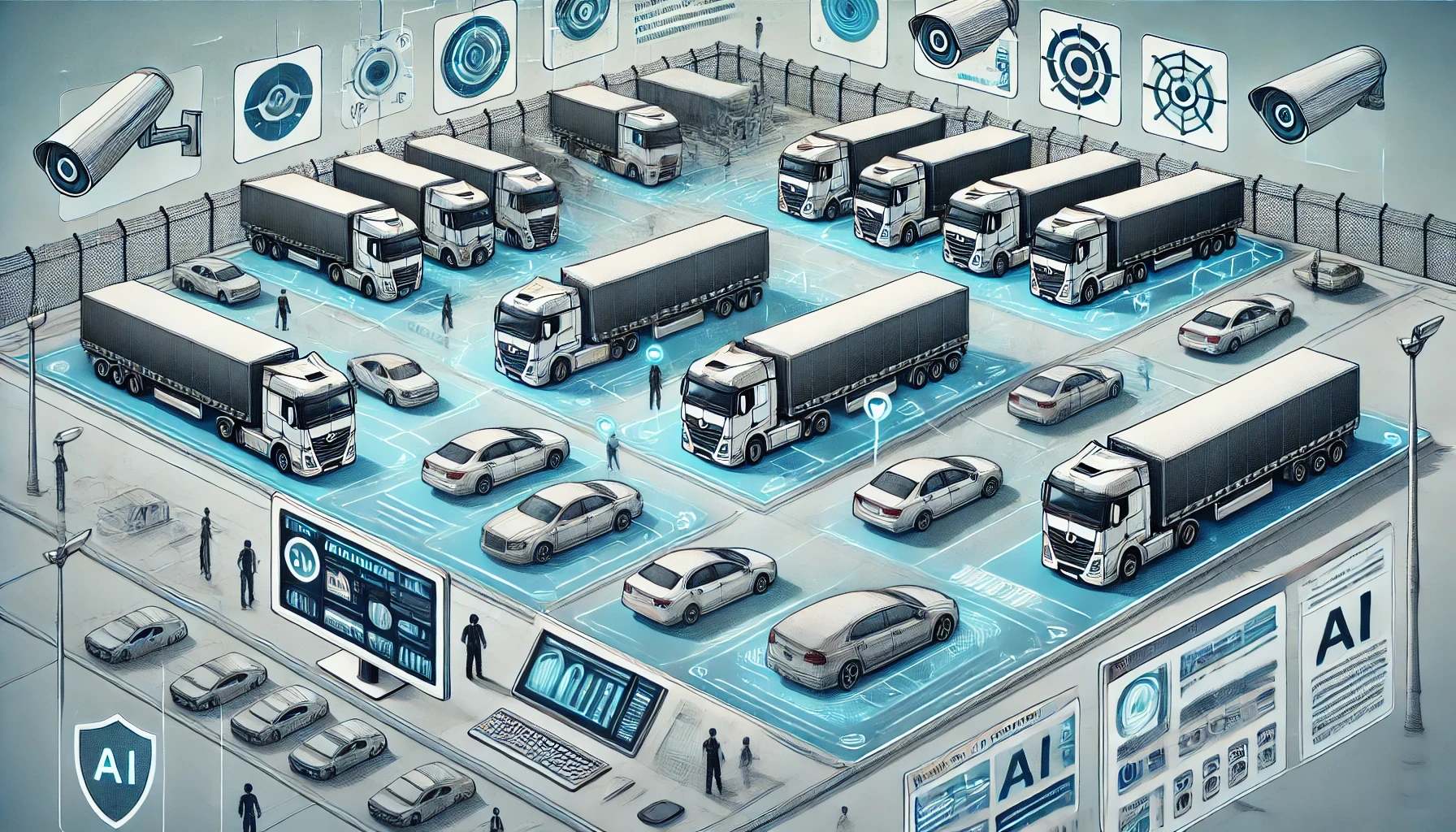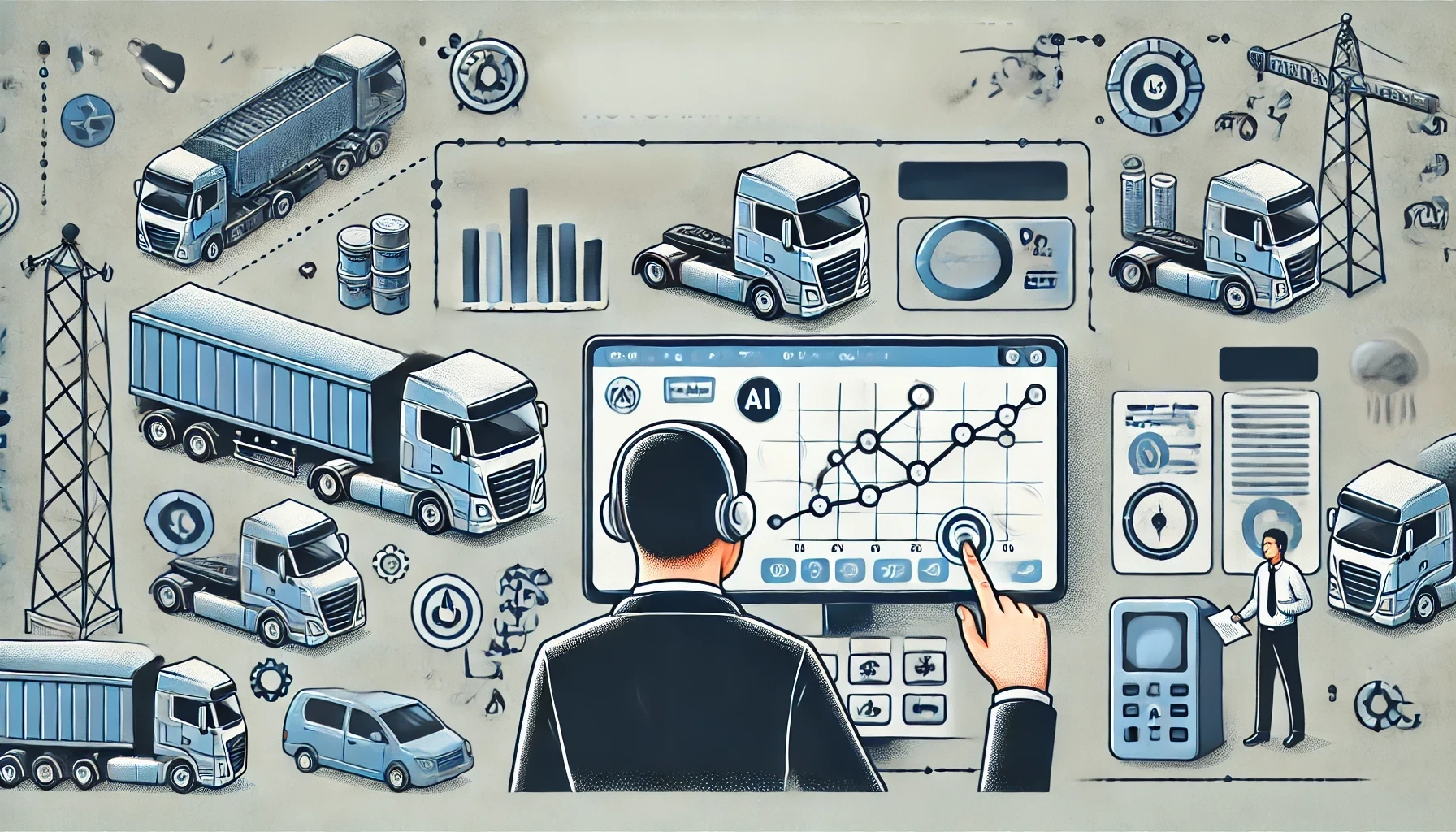How AI-Powered Image Recognition Improves Fleet Management in Transportation
Introduction: The Evolving Landscape of Fleet Management
The transportation and logistics industry is becoming increasingly complex, driven by the rising demand for efficiency, sustainability and safety. As supply chains grow more intricate and fleets expand, the need for optimized operations has never been greater. Fleet managers face the constant challenge of ensuring vehicles are well-maintained, drivers are operating safely and routes are efficient, all while reducing operational costs. In this environment, the introduction of cutting-edge technologies, such as AI-powered image recognition, is transforming the way fleets are managed.
Technological advancements, particularly in artificial intelligence (AI) and image recognition, are modernizing fleet management by automating routine processes, improving safety measures and optimizing resource use. AI image recognition, capable of detecting objects, reading license plates and even assessing vehicle conditions, allows fleet operators to make data-driven decisions that enhance efficiency and reduce downtime. This real-time intelligence enables proactive vehicle maintenance, streamlines compliance checks and ensures better asset tracking, leading to more effective fleet management overall.
In today’s data-driven world, actionable insights are key to unlocking higher levels of fleet optimization. AI systems can analyze vast amounts of visual data, offering fleet managers a comprehensive view of vehicle performance, driver behavior and maintenance needs. By leveraging image recognition technology, fleet operators are empowered to enhance productivity, cut costs and improve safety — paving the way for a smarter, more efficient future in transportation logistics.
AI image recognition fits seamlessly into this evolving landscape by providing innovative solutions to everyday challenges in fleet management. From automating vehicle inspections to enhancing security through facial recognition and object detection, AI-powered technologies are reshaping how fleets operate, offering an essential tool for modern logistics management.
How AI Image Recognition Works in Fleet Management
AI-powered image recognition is revolutionizing the transportation and logistics sectors by enabling fleet managers to streamline operations, enhance safety and improve decision-making. In fleet management, AI image recognition leverages machine learning algorithms to process and analyze visual data from vehicles, infrastructure and surrounding environments. This technology allows fleets to automatically identify, track and assess vehicles, reducing the need for manual inspections and increasing the overall efficiency of fleet operations.
At the core of AI image recognition in fleet management are several key components: machine learning, object detection, optical character recognition (OCR) and automated data extraction from vehicle images. These technologies work together to capture and interpret crucial information from images, whether through cameras installed on fleet vehicles or during inspections.
Machine learning allows AI systems to continuously learn from the visual data they process, becoming more accurate over time in identifying patterns, recognizing objects and predicting potential issues. In fleet management, this means that the system can better detect wear and tear on vehicles, track fuel efficiency and even identify changes in driver behavior.
Object detection enables AI to recognize various elements such as vehicles, pedestrians and road conditions. In the context of fleet management, this helps monitor the surroundings, ensuring vehicles are operating in safe environments and adhering to regulations. Object detection can also assist in identifying specific parts of a vehicle that require maintenance, improving safety and reducing downtime.
Optical character recognition (OCR) plays a pivotal role in automating fleet documentation. By extracting information from images of number plates, vehicle registration papers and compliance documents, OCR eliminates the need for manual data entry. This speeds up the process of managing large fleets and ensures that documentation is accurate and up-to-date, supporting regulatory compliance.
AI image recognition processes real-world data points such as license plate recognition, vehicle identification and automated vehicle inspections. For example, number plate recognition allows fleets to automatically log vehicles entering and exiting depots, while vehicle identification helps track different models, their condition and usage patterns. Automated inspections, using AI-driven image analysis, can detect anomalies like cracks, dents, or malfunctioning parts, significantly reducing the need for manual checks.
By combining these advanced technologies, AI image recognition provides fleet managers with actionable insights that improve safety, reduce operational costs and optimize the overall performance of transportation logistics. These automated processes not only save time but also lead to more informed decisions that drive fleet efficiency.
Enhancing Vehicle Monitoring and Maintenance
AI-powered image recognition is transforming vehicle monitoring and maintenance, offering fleet managers the tools to maintain optimal vehicle performance while reducing downtime and costly repairs. Traditionally, fleet maintenance relied on manual inspections, which are time-consuming, prone to human error and often reactive. With AI image recognition, monitoring fleet conditions becomes a proactive, automated process, allowing fleet managers to identify potential issues before they escalate into larger problems.
One of the primary roles of AI image recognition in fleet management is conducting automated visual inspections. By using advanced object detection and anomaly detection technologies, AI systems can analyze images of fleet vehicles to detect signs of damage, wear and tear, tire pressure issues and more. For example, high-resolution cameras can capture images of a vehicle’s exterior, which are then processed by AI algorithms to detect cracks, dents, or other abnormalities that might indicate the need for repair. This enables fleet managers to address these issues before they lead to mechanical failures or accidents on the road.
Proactive maintenance scheduling is one of the biggest advantages of AI-powered vehicle monitoring. By continuously analyzing visual data from fleet vehicles, AI systems can predict when a vehicle may need servicing, whether it’s a brake pad replacement, an oil change, or addressing tire wear. This predictive approach not only extends the lifespan of the vehicles but also significantly reduces downtime, keeping fleets operational and minimizing the disruption to transportation logistics.
A practical use case of AI in fleet maintenance can be found in object detection systems, which can assess the condition of key vehicle components, such as windshields, lights and tires, in real time. If any irregularities are detected, the system flags these anomalies, alerting the fleet manager to schedule maintenance before the issue worsens. Similarly, anomaly detection can help identify patterns in vehicle behavior that suggest underlying mechanical issues, such as unusual vibrations or uneven tire wear, which might not be visible to the naked eye but are critical to address early.
By integrating AI-powered image recognition into fleet management, companies can ensure their vehicles are always in peak condition, resulting in safer operations, fewer breakdowns and substantial cost savings. This advanced monitoring capability empowers fleet managers to stay ahead of maintenance needs, reducing the risk of unexpected repairs and enhancing the overall efficiency of transportation logistics.
Improving Driver Safety and Behavior Monitoring
Ensuring driver safety is one of the most critical aspects of effective fleet management and AI-powered image recognition is playing a significant role in enhancing safety protocols. By analyzing visual data in real-time, AI image recognition systems can monitor driver behavior and the environment around the vehicle, ensuring that drivers adhere to safety standards and helping prevent accidents before they occur.
AI-powered image recognition is particularly useful in detecting signs of driver fatigue, seatbelt usage and distracted driving. Through advanced facial recognition and object detection technologies, AI systems can track a driver’s eye movements, head position and facial expressions to identify signs of drowsiness or inattention. For instance, if a driver is frequently looking away from the road or showing signs of fatigue, the system can trigger alerts to warn the driver or notify fleet managers in real time. Similarly, AI can detect whether a driver is wearing a seatbelt, ensuring compliance with safety regulations.
One of the key benefits of integrating image recognition into fleet management is its ability to provide real-time monitoring, which is crucial for accident prevention. By constantly analyzing visual inputs, AI systems can identify risky behaviors, such as texting while driving or not paying attention to the road and take immediate action by sending alerts or even autonomously intervening. This proactive approach helps prevent accidents, reduces liability and enhances the overall safety of the fleet.
In addition to monitoring drivers, AI-powered image recognition can also analyze the driving surroundings, detecting road conditions, vehicle proximity and potential hazards. For example, object detection can identify nearby vehicles, pedestrians, or obstacles, ensuring drivers maintain safe distances and react appropriately to sudden changes in traffic. Monitoring road conditions — such as detecting icy roads, potholes, or construction zones — further ensures that drivers can navigate safely, even in challenging environments.
By incorporating AI-driven behavior monitoring, fleet managers can ensure that drivers are operating vehicles safely and in compliance with regulations, ultimately reducing accidents and protecting both drivers and assets. The ability to monitor and correct unsafe behavior in real-time provides a significant boost to fleet safety, making it an essential tool for modern fleet management.
Streamlining Fleet Documentation and Compliance
Fleet management involves handling an extensive amount of paperwork, from vehicle registration and insurance forms to compliance documents and maintenance logs. Manually managing these documents can be both time-consuming and prone to errors, making it difficult to ensure regulatory compliance and maintain accurate records. AI-powered Optical Character Recognition (OCR) is transforming the way fleet managers handle documentation by automating the extraction, processing and management of vital information.
AI-powered OCR plays a crucial role in automating document processing, allowing fleet managers to digitize paper-based records and streamline their workflows. By scanning and interpreting text from images of documents, OCR technology can automatically extract key details, such as vehicle identification numbers (VINs), registration dates, insurance information and compliance status. This automation eliminates the need for manual data entry, significantly reducing the likelihood of human error and ensuring that all necessary documentation is accurate and up to date.
In the context of fleet management, OCR is particularly beneficial for processing large volumes of documents related to vehicle registration, insurance and compliance. For instance, when new vehicles are added to the fleet, OCR can quickly extract registration details from scanned forms, automatically updating the fleet management system. This makes it easier for fleet managers to track the status of each vehicle and ensure that all necessary documentation is in order, especially for regulatory audits or inspections.
One of the major advantages of using AI-powered OCR is the ability to simplify audit trails and ensure smooth regulatory checks. Fleet managers can quickly retrieve and review digitized documents, ensuring that all records are properly organized and accessible. This reduces the time spent on audits and compliance checks, as all relevant information is stored in a digital format that can be easily searched and verified. Additionally, by reducing manual paperwork, OCR helps to prevent errors that could otherwise lead to non-compliance or costly fines.
A real-world use case of OCR in fleet management involves digitizing and managing fleet paperwork. Instead of manually sorting through piles of registration forms, fleet managers can scan these documents, allowing OCR technology to process the data and automatically update records. This not only saves time but also ensures that fleet operators are always ready for audits and inspections with accurate, organized documentation.
By leveraging AI-powered OCR, fleet managers can dramatically improve their documentation processes, saving time, reducing errors and ensuring full compliance with industry regulations. The ability to automatically extract and process essential information from vehicle-related documents makes AI a valuable tool for any fleet looking to enhance efficiency and simplify its operations.
Optimizing Route Planning and Asset Tracking
Efficient route planning and asset tracking are vital components of fleet management, directly impacting fuel costs, delivery times and overall productivity. AI-powered image recognition is reshaping how fleet managers optimize routes and monitor assets, providing real-time insights that allow for more strategic decision-making. By integrating advanced AI technologies such as automated license plate recognition and GPS data, fleets can streamline operations, reduce costs and maximize efficiency.
One of the ways AI image recognition enhances fleet management is through its ability to track vehicle location and monitor assets. Using cameras installed on fleet vehicles and in logistics hubs, AI-powered systems can automatically detect and read license plates, ensuring that fleet managers always know where each vehicle is located. This technology, combined with GPS data integration, provides a comprehensive, real-time view of fleet activity, allowing managers to monitor vehicle movements, track shipments and ensure that assets are where they need to be at any given time.
The integration of real-time data from AI image recognition systems with GPS tracking enables improved efficiency in route planning. By continuously monitoring vehicle locations and environmental conditions such as traffic patterns, road closures, or adverse weather, AI can suggest the most efficient routes, helping drivers avoid delays and reduce travel time. For instance, if a traffic jam is detected, the AI system can instantly recalibrate the route, guiding drivers through less congested roads, which minimizes fuel consumption and ensures timely deliveries.
The benefits of AI-powered asset tracking and route optimization extend beyond just improved logistics. For fleet managers, this technology translates into significant cost reductions, fuel savings and more optimized routes. By cutting down on unnecessary mileage and reducing idle times, fleet managers can save on fuel costs while also reducing wear and tear on vehicles. This leads to fewer maintenance issues and ensures that fleets are running at peak performance for longer periods.
Moreover, AI-driven route planning not only reduces costs but also enhances customer satisfaction by improving delivery accuracy and timeliness. Real-time tracking ensures that fleet managers can provide precise arrival estimates, enabling better communication with clients and reducing the likelihood of late or missed deliveries.
In summary, AI-powered image recognition, in conjunction with GPS data, provides fleet managers with actionable insights that help them optimize routes, track assets in real time and reduce operational costs. By integrating these technologies into fleet management, businesses can achieve higher levels of efficiency, increase profitability and improve their transportation logistics.
Enhancing Security and Theft Prevention
Fleet security is a top priority for fleet managers and AI-powered image recognition is playing a crucial role in safeguarding vehicles and assets from theft and misuse. With the growing complexity of transportation logistics, securing fleet vehicles has become more challenging, but AI image recognition offers an advanced, automated solution for monitoring, detecting and preventing unauthorized access or suspicious activities in real time.
One of the key applications of AI image recognition in fleet security is its ability to detect unauthorized access using facial recognition and license plate monitoring. AI systems can automatically verify the identity of drivers and ensure that only authorized personnel have access to fleet vehicles. For example, if someone attempts to access a vehicle who is not recognized by the system, an alert can be triggered, allowing fleet managers to take immediate action. Similarly, automated license plate recognition can monitor vehicle entry and exit points, ensuring that only registered vehicles are on the premises or on designated routes.
AI-powered image recognition also excels in monitoring and preventing theft or misuse of fleet vehicles through real-time surveillance and object recognition. By continuously analyzing visual data from cameras installed on vehicles or in fleet depots, AI systems can identify unusual or suspicious behavior, such as unauthorized movement of a vehicle or tampering with vehicle components. Real-time alerts are sent to fleet managers, enabling them to take swift action to prevent theft or damage.
An example of this in action is image-based surveillance with AI anomaly detection, where AI systems can monitor vehicles around the clock and flag any irregular activities. For instance, if a vehicle is being accessed outside of regular operating hours or if an individual is seen loitering near a vehicle, the system can detect this anomaly and immediately notify security teams. This proactive approach helps fleet managers prevent theft before it occurs and protect their valuable assets.
By enhancing security with AI-powered image recognition, fleet managers can significantly reduce the risk of vehicle theft and misuse, ensuring that their fleet operates safely and securely. This technology provides a comprehensive layer of protection that goes beyond traditional surveillance methods, delivering real-time insights and automated responses that keep fleet assets secure at all times.
Reducing Costs with Automation and Efficiency
One of the most compelling advantages of implementing AI-powered image recognition in fleet management is the potential for significant cost reductions. By automating key processes such as vehicle inspections, document management and route optimization, fleet managers can dramatically lower operational costs while increasing overall efficiency. As fleets grow in size and complexity, the ability to streamline operations using AI becomes an invaluable asset.
AI-powered image recognition directly reduces labor costs by automating visual inspections and document processing. Tasks that once required manual labor, such as checking vehicles for damage or wear, can now be handled by AI systems equipped with object detection and anomaly detection capabilities. These systems can quickly and accurately assess vehicle conditions, flagging any issues that require attention and drastically reducing the need for manual, time-consuming inspections. Similarly, AI-driven Optical Character Recognition (OCR) can automatically extract and process important fleet documents, including vehicle registration, insurance papers and compliance certificates, eliminating the need for manual data entry and reducing the risk of errors.
In addition to reducing labor costs, AI-powered image recognition helps fleet managers optimize fuel usage and reduce repair costs. By integrating real-time data from vehicle monitoring systems, AI can track vehicle performance and driving behaviors that impact fuel efficiency. For example, image recognition systems can monitor tire conditions and other factors affecting fuel consumption, allowing fleet operators to take corrective actions before they lead to costly inefficiencies. AI systems can also predict when vehicles need maintenance, reducing the likelihood of major repairs and preventing unexpected breakdowns, which can be costly in terms of both time and money.
Furthermore, enhanced productivity is another benefit of automation in fleet management. By leveraging AI-powered tools for routine tasks like document management, vehicle tracking and compliance checks, fleet managers can focus on more strategic activities that drive business growth. The time saved through automation can be redirected to optimizing logistics, improving customer service and expanding fleet capacity — all of which contribute to the bottom line.
For example, a fleet operator could use AI to automate the processing of vehicle inspection reports. Instead of dedicating hours to manually reviewing and entering data, the system automatically captures relevant information from vehicle cameras and inspection forms. This not only saves time but ensures that all reports are consistent and accurate, further reducing administrative costs.
In summary, by automating routine tasks with AI-powered image recognition, fleet operators can achieve significant cost savings across multiple areas, from labor and fuel costs to vehicle maintenance and administrative work. These technologies enable fleets to operate more efficiently and productively, ultimately improving the profitability and sustainability of transportation logistics.
Sustainability in Fleet Management
As sustainability becomes a growing priority for businesses and industries worldwide, fleet management is no exception. Transportation and logistics companies are under increasing pressure to minimize their environmental impact, reduce carbon emissions and adopt eco-friendly practices. AI-powered image recognition plays a pivotal role in supporting sustainable fleet operations, helping fleet managers monitor vehicle performance, reduce inefficiencies and promote greener driving behaviors.
One of the key ways AI-powered image recognition contributes to sustainability is by tracking vehicle emissions. AI systems can analyze vehicle conditions through real-time image data, such as tire wear, engine performance and other factors that affect fuel efficiency and emissions output. By continuously monitoring these elements, fleet managers can identify underperforming vehicles that may be emitting higher levels of pollutants. This real-time data allows fleets to address maintenance issues early, ensuring that vehicles are running at optimal efficiency and within environmental regulations.
Additionally, AI-powered image recognition helps fleet managers detect inefficiencies that may contribute to higher fuel consumption and emissions. For example, AI systems can monitor driving behaviors such as excessive idling, harsh braking, or aggressive acceleration — practices that increase fuel consumption and wear on the vehicle. By flagging these behaviors, AI helps fleet managers implement driver training programs that encourage more fuel-efficient driving practices, ultimately reducing the fleet’s environmental impact.
AI also plays a crucial role in monitoring vehicle performance to reduce the overall environmental footprint of fleet operations. Through the continuous analysis of image data, AI can predict when vehicles need servicing, preventing breakdowns and ensuring that vehicles operate at peak performance. Proactively maintaining fleet vehicles not only reduces repair costs but also ensures that vehicles are consuming fuel efficiently, producing fewer emissions and contributing to a lower carbon footprint.
For fleet managers focused on sustainability, AI-powered image recognition offers the ability to make data-driven decisions that balance operational efficiency with environmental responsibility. By optimizing fuel usage, reducing emissions and encouraging greener driving behaviors, AI supports the shift toward more sustainable transportation logistics.
Conclusion: The Future of Fleet Management with AI Image Recognition
AI-powered image recognition is already transforming fleet management, offering unparalleled advantages in automation, efficiency, safety and sustainability. By enabling automated vehicle monitoring, real-time asset tracking, proactive maintenance and streamlined documentation, AI technologies help fleet managers overcome the operational complexities of today’s transportation logistics. The integration of AI-driven tools is not only reducing costs and enhancing safety but also promoting eco-friendly practices through better fuel management and reduced emissions.
Looking ahead, the future of fleet management is poised to become even more advanced with continued innovation in AI-driven predictive maintenance, fully autonomous fleets and smarter logistics. AI image recognition will play a central role in predicting vehicle issues before they occur, reducing downtime and ensuring optimal fleet performance. As the transportation industry moves toward automation, AI will be at the heart of managing autonomous fleets, enabling real-time decision-making and seamless operations without human intervention.
Moreover, as logistics become more complex, smarter fleet management systems powered by AI will be critical in optimizing routes, reducing operational costs and enhancing customer satisfaction. The ability to analyze massive amounts of visual data in real time will allow fleet operators to respond to changes in traffic, weather and road conditions with unprecedented accuracy and speed, making transportation logistics more dynamic and efficient than ever before.
As AI technologies continue to evolve, so too will their impact on fleet management. Continued innovation in AI-powered image recognition will lead to smarter, more sustainable and more efficient transportation systems, helping fleet managers stay ahead in a rapidly changing industry. By embracing these advancements, fleet operators can unlock new levels of productivity, cost savings and environmental responsibility.

